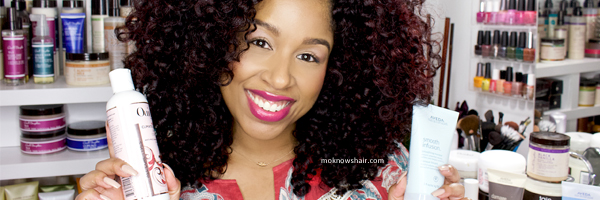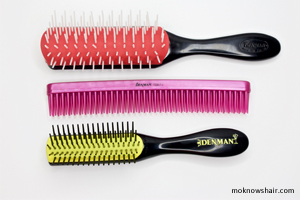
Do you have super frizzy, barely-there curls that won’t hold style and feel like straw even though you frequently use TWO conditioners on wash day? If you’re using a rinse-out/daily conditioner and deep conditioner/mask/treatment in the same wash day routine, you’re wasting your time and product.
First, let’s clarify the difference between the two!
RINSE-OUT/DAILY CONDITIONERS are surface conditioners made to protect, smooth or hydrate (depending on the formula) for 1-3 days. Because they are made for surface conditioning (think: outer strand), their processing times are short and they generally feel more slippery on the hair (by the way, “slip” is not an indicator of effectiveness). They are typically designed for people who wash often (every 1-3 days) or those not in need of treatments with every wash.
DEEP CONDITIONERS/MASKS/TREATMENTSare formulated with lower molecular weight allowing them to penetrate strands with lasting affects of repair/hydration for 4-7 days on average. Because they are more concentrated and designed to do more, their price tags are usually higher than rinse-outs. For curly strands, you will need deep conditioning to maintain protein-moisture balance (elasticity). Applying a heat source with a conditioning cap, warm towel wrap or hooded dryer can help your hair better absorb the treatment. Steaming your hair is an even better way to install moisture as hooded steamers use fresh water to penetrate versus the recycling method of the greenhouse effect when covering with a plastic cap.
If you wash every 5-7 days, you will want deep conditioners/treatments. Most curly hair types benefit from alternating a repairing/restructuring treatment with a moisturizing treatment. And remember, it will take several uses of any treatment to see if it is beneficial to your hair. If you switch conditioners every wash, you’ll never know what works as you haven’t given it any time to have an impact. Also, you should follow instructions on the label for timing as excessive lengths of time and overnight conditioning can cause strands to swell too much or over-process. More is not better, it’s often damaging.
If you’re going longer than seven days between washes on average, and your hair is giving you the blues, consider washing more often. Long periods between washing renders hair dry, causes breakage, induces scalp issues, allows for greater build-up of product and dirt, and entanglement of shed hair making your wash process difficult and your hair damaged.
So, why not use both types of conditioner in the same wash day?
After shampooing, if you apply a rinse-out conditioner, your pH lowers and the conditioner attaches to the outside of your strands. Your deep conditioner has a lower pH than shampoo as well so it will sit on top of your rinse-out conditioner and next to nothing is happening; you’re not getting the benefits of the treatment because your strands are already covered by the first conditioner you applied. You are essentially wasting your time and your money as you rinse your deep treatment down the drain.
I’ve been told by many of my clients they use a rinse-out conditioner before treatment for detangling help. Once I show them that’s not necessary, their minds are blown and they are forever changed. If you’re using rinse-out conditioner to detangle, consider:

- washing more often (with shampoo) so your hair doesn’t become dry from build-up and overly tangled in the first place. If you are opting to not use shampoo, your hair is drying out from product build-up and dirt. Conditioner is not a cleanser – using it as shampoo is like rinsing your body off in the shower with just water, stepping out, putting on lotion and calling yourself clean.
- exploring other (think: higher quality than whatever you are currently using) brands – maybe what you’re using isn’t a good fit for you.
- finding a better comb/brush to help with detangling and shed hair removal. You can also try using vinyl gloves to help with separating hair before combing/brushing.
- adding a pre-poo treatment to your routine.
What about leave-ins?
LEAVE-IN CONDITIONERS are an extension of your conditioner. While they can be good for added moisture, detangling, or as a base for styling, they are not mandatory. If you have deep conditioned your hair, or depending on the styling product you intend to use, you may not need one.
LEAVE-IN TREATMENTS are made to improve manageability or help with repair, restructuring or elasticity. They can focus on reducing breakage, repairing the cuticle layer of the strand, taming frizz, or smoothing strands for protection during styling. These are not mandatory, but can be used to target an issue or for general maintenance.
The type of leave-in you choose depends on the state of your hair (breaking, dry, compromised elasticity, overly frizzy, chemically damaged, heat damaged) which determines whether or not you need to use one. Assess your hair’s needs before choosing. Then read the product label, benefits, and claims. Pay attention to how your hair performs after several uses and make adjustments where necessary.
In conclusion…
There is no one type of treatment schedule to follow as everyone’s needs are different, so asking your neighbor may not serve YOU. If you’re struggling, pay attention to your hair. Keeping notes and taking pictures of results will give you clarity on what’s working and finding a stylist that understands textured hair to evaluate your hair in-person will equip you with more accurate, personalized advice.
Also, when watching my YouTube channel, pay attention to the processes – actually look at the order of steps taken. Notice the progression from shampoo to conditioner and then on to leave-in and/or styling product. My goal is to help you understand the science of hair care so your routine is easier and more enjoyable!
